Man and myth, Part II: A return to Brotherhood Raceway, and Big Willie Robinson’s legacy

- Share via
The Chevrolet gasser blasted through salt air across a desolate stretch of land.
An old Buick hearse with flames painted on its flanks thundered to keep pace.
The cars flashed in a bright blur.
They crossed the finished line — an unforgiving place where bragging rights are earned and engines go quiet. The street racers climbed out of their cars and embraced.
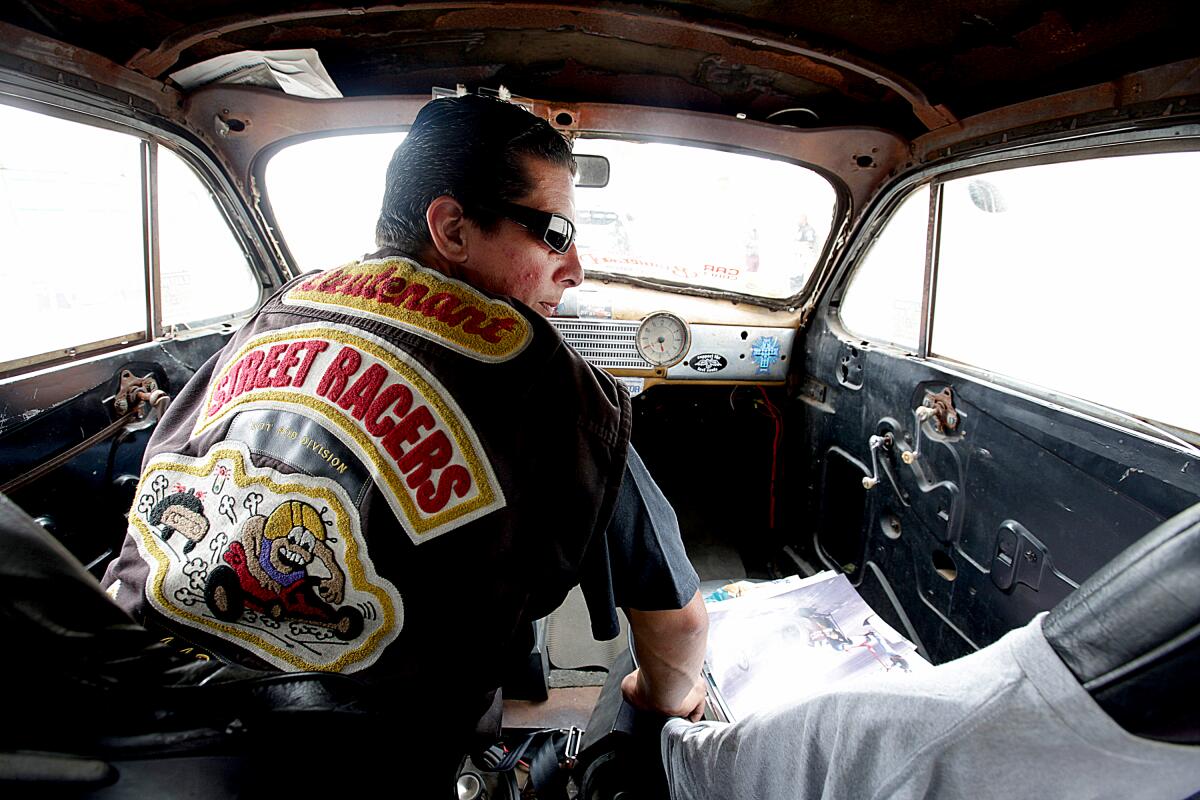
“This is freaking crazy, man, just being out here to do this,” said Donald Galaz, who drove the Chevy. “A lot of people ain’t going to believe us that the gasser raced a hearse down here on Terminal Island today.”
We were out in the Port of Los Angeles — visiting the former site of the drag strip founded in 1975 by Big Willie Robinson, the leader of the Brotherhood of Street Racers.
Operating on and off for two decades, Brotherhood Raceway Park was a place where everyone was welcome — cops and criminals, movie stars and miscreants, even Crips and Bloods — and L.A. was the better for it.
“It provides not only an opportunity to give these youngsters an outlet, but it helps build brotherhood,” said then-L.A. Mayor Tom Bradley in 1977 during a visit to the track he helped open. “They are built on the theme of brotherhood through street racing.”
But the track on Terminal Island was shut down 24 years ago by the Los Angeles Harbor Department, which wanted back the city-owned land for a port-related use. Today, the property is just a barren expanse, taunting racers who once wowed crowds of thousands there. This race — it was surreptitious, and it was the only contest of the day, a visit that required approval from the L.A. Port Police. Still, it was a thrill to see some fast cars return to the site of Big Willie’s greatest glories as part of my reporting for “Larger Than Life,” a documentary podcast from The Times that concluded Tuesday.
As the two Brotherhood members raced their cars down the road, they kicked up tons of dust. It billowed high in the air, watering eyes and blanketing the site of Brotherhood Raceway for just a moment, giving it a dream-like sheen. The chirp of the seagulls. The water stretching beyond. The burbling idles of the Chevy and the Buick reverberating in our chests. It could’ve been 1976 or 1983 or 1994.
It felt like we were communing with the dead. All the people who made this place what it once was. Especially Big Willie.
“You can’t take that away,” said the other racer, Fabian Arroyo.
::
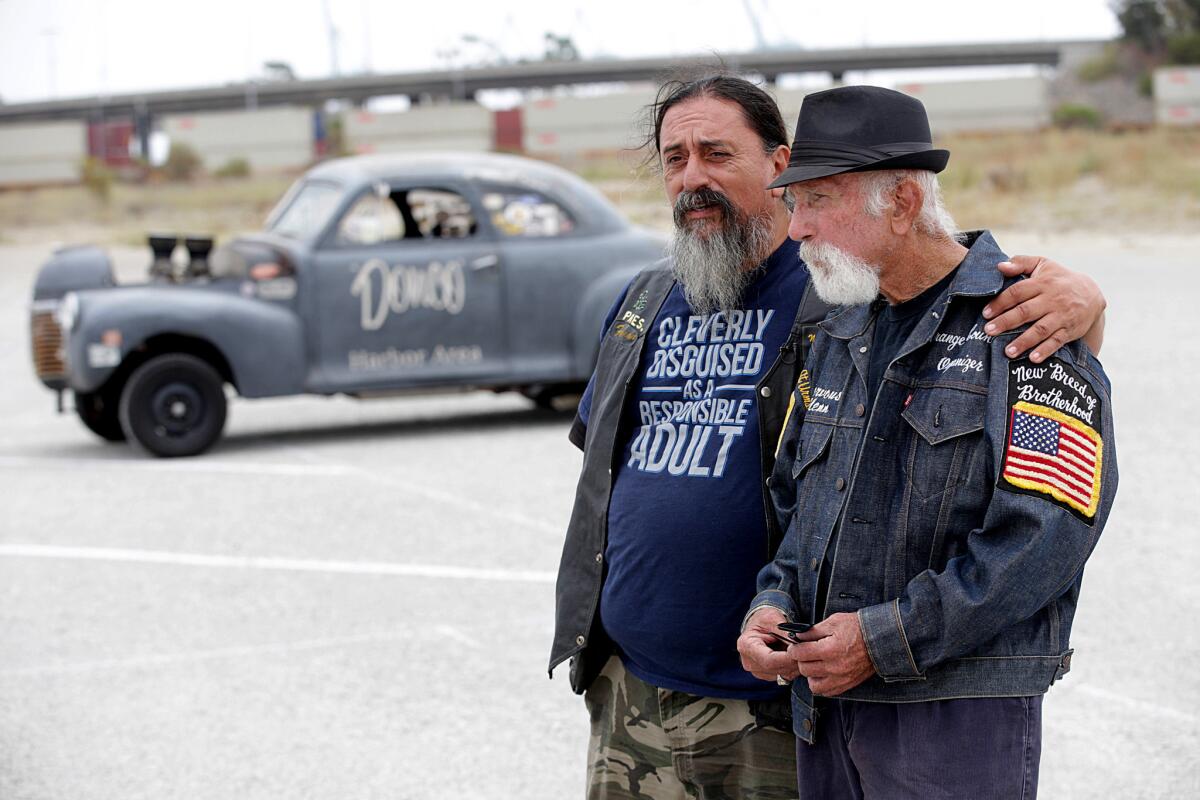
For Big Willie, Brotherhood Raceway was the culmination of his life’s work. He wanted to give the gift of inclusion to other people — one he was denied as a teenager at LaPlace Raceway near New Orleans, where he had to watch the action from the “colored” section because black people weren’t allowed to compete. So at his track, Willie — with help from his drag racing wife, Tomiko — deployed his “run whatcha brung” philosophy, welcoming all racers to his seaside spot. That was his motto — it meant that any car, and any driver, could get a race.
But living up to this credo was dangerous, because it meant that truly anyone would be welcome — including members of opposing street gangs. And in the years before the track opened, two notorious gangs, the Bloods and the Crips, both gained footholds in South Los Angeles. Willie could’ve barred these gangsters from his track, but instead he welcomed them.
“I want you guys to come in peace,” Willie said. “We are not going to check nobody for guns, we are not going to check no cars. You guys are going to come in honor, man.”
Willie’s audacious — and dangerous — plan worked. Before long, those gang members were racing alongside celebrities and L.A. power players: Both actor Steve McQueen and former L.A. Times Publisher Otis Chandler, who was a benefactor of Willie’s, visited the track.
And Brotherhood Raceway had an impact: Everyone from beat cops to high-ranking Los Angeles Police Department officials and ex-L.A. City Council members said it. Several noted that crime related to street racing went down and some gang-related offenses went down, too.
Larger Than Life: Amid racial strife, Big Willie Robinson sought to forge peace, one street race at a time
“That guy was a crime stopper,” said L.A. Police Commission President Steve Soboroff, who served on the Harbor Commission in the mid-1990s and got to know Willie then. “The reduction in drag-racing accidents and injuries during the time [his track was] open here was always a significant number. Police would always tell me that. Because everybody came down there.”
In a city that at times could seem saturated in violence, Arroyo and others said Brotherhood Raceway was neutral ground, which was only part of what made it special.
“I mean, the place had an ambiance,” he said. “You had a little bit of fog that came in, you can smell the ocean. The cars went faster there than anywhere else. There was a little chill in the air, but it wasn’t cold. The atmosphere with the people around you, it was just like no other place.”
But I was even more captivated by the man who made Brotherhood Raceway happen — Willie Andrew Robinson III. To achieve his goals, he made himself into the larger-than-life figure of Big Willie. The character he cultivated — the peacemaker, the street statesman, the war hero — helped change a city. But there was more to his story.
::
Willie’s Vietnam War service was central to his myth, and a major part of his persona. He long said that he’d been drafted by the Army in 1964 and served as a Green Beret.
“Technically we didn’t exist. We were like James Bond,” Willie told Arroyo in a 2009 interview that the latter shared with The Times. “Yes, we were trained like James Bond. Our bosses in Vietnam was the CIA.”
Friends, family and members of the Brotherhood heard Willie’s stories of valor, and they’ve become well-worn tales swapped by those in the street racer’s circle: Willie was a bomb disposal technician. Willie jumped out of airplanes. Willie ate snakes to survive.
Cops and politicians who backed him and his group heard the tales of bravery, too. Those credentials may have opened doors for Willie after the 1965 Watts riots, because Los Angeles — for all of its progressivism — remained a deeply divided place.
“Back then, when I went through the academy in 1970, I bet you 60-70% of the class were all veterans,” said James Bultema, a former member of the LAPD who joined the force after his own service in Vietnam and later became a historian, writing books about the Police Department. “So, he has that background, [it] would have won him over to a lot of cops.”
It wasn’t just beat cops. Robert Farrell, an ex-L.A. city councilman who supported Willie, said the street racer got powerful people to listen, including members of the LAPD who helped him stage races on city streets, starting in the late 1960s.
“He also had an ability to influence the guys like the Tom Bradleys, and myself, and some of those law enforcement people who rallied to his support,” Farrell said.
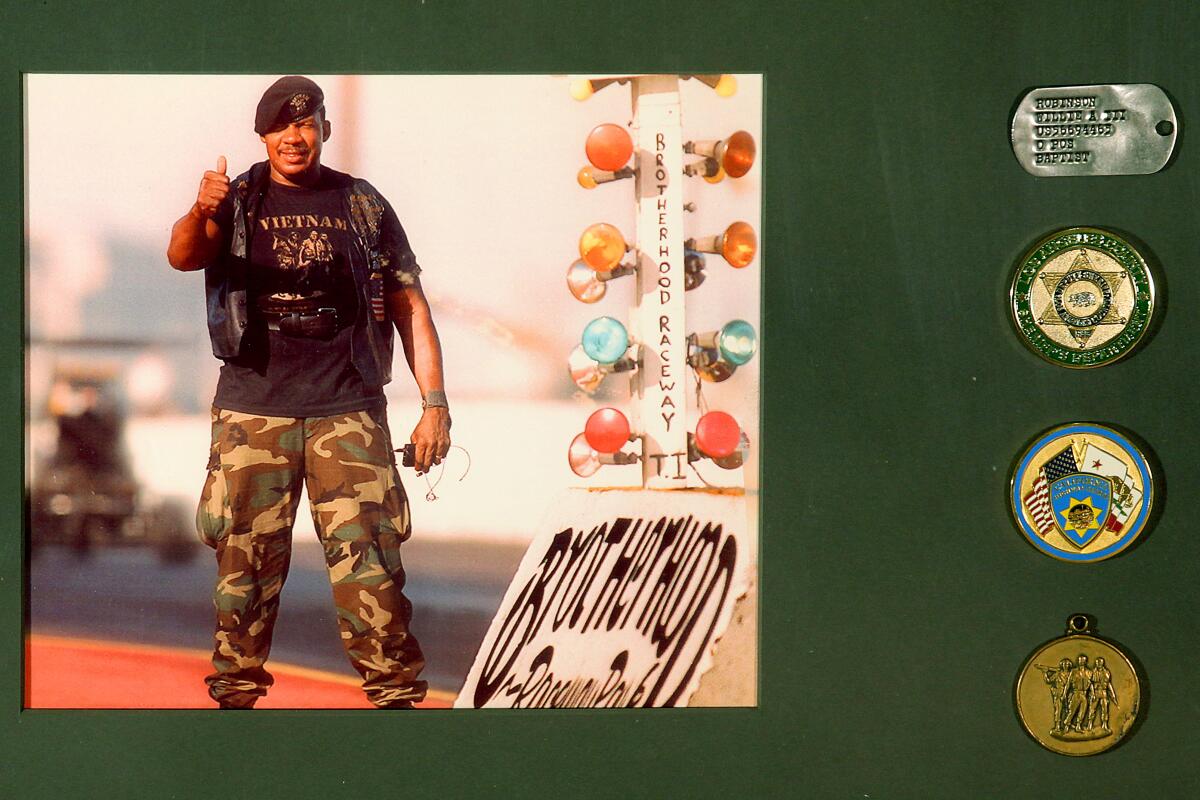
The war hero myth was powerful. And Willie reinforced it, wearing fatigues and a beret decades after the fighting in Vietnam ended. But even early on in my reporting, certain things about this story seemed off. Take, for example, my interview with Willie’s younger brother, Don Ray Robinson. He brushed off innocuous questions about Willie’s military service and whether it helped him as the leader of the Brotherhood.
“That had nothing to do with his career,” he told me sternly.
When I tried to press on, Robinson cut me off.
“Certain things in life, you don’t talk about — I don’t think it’s supposed to be talked about,” he said.
At the time, Robinson’s reaction was strange — and piqued my interest. As part of my reporting, I went to the source: the Army. I filed a public records request under the Freedom of Information Act, figuring anything I learned about Willie’s military service would burnish his story.
Months later, an envelope from the Army arrived.
The military records indicate Willie never completed basic training and was honorably discharged in 1966 due to a preexisting medical issue. The story Willie told that impressed politicians and police — that he fought in the Vietnam War — is a lie.
Willie always said he began his service in 1964, but the 23-page Army file shows he was inducted in 1966. There were immediate signs his physical condition would be an issue. His entry record lists “back and feet trouble” in a box where “physical defects” were to be noted. Less than a month into basic training at Ft. Bliss in Texas, his health was reevaluated and he got the lowest possible scores for his overall physical capacity and his legs. I asked Kevin Walton, a former Air Force communications analyst, what that meant for Willie.
“Some of the scores that he got on his physical tests — that was most likely a disqualifying factor,” said Walton.
At 6-foot-6 and 300 pounds, Willie’s strength and size were his trademark, and no one ever told me he had troubles like these. Within days of the test, Willie wrote a letter to the commanding general at the Army hospital in El Paso, requesting a discharge for “physical disability.” Willie said he’d been notified that he was considered “unfit for retention in the military service.” A few weeks later, his discharge was approved.
I was stunned. From the beginning, I was fascinated by the tale of a war hero who returned home and then accomplished something even more incredible than anything he ever did on the battlefield. I felt betrayed, lured into the myth of a man’s calculated reinvention. But maybe the lie allowed him to achieve so much. Did he believe the ends justify the means? Or was his motivation more personal? I needed to know. I spoke to all sorts of people, including representatives of Guardians of the Green Beret and P.O.W. Network, groups that bring military fraudsters’ false stories to light and honor real heroes. They helped me make sense of Willie’s military records and his claims.
Mary Schantag, co-founder of P.O.W. Network, said she considers Willie “somebody that used a false narrative to get wherever he went in life.”
“The fact that he spent his days in fatigues, and he spent his days telling a Vietnam story that cannot be authenticated — to me, it just crushes those that earned that,” Schantag said.
But other people with connections to the military saw things differently. Walton, who served in the Air Force for six years, acknowledged how tough it is to reconcile Willie’s lies with the man he made himself out to be. However, he ultimately focused on the good that Willie did. “I think that his legacy of healing racial tensions is something that people should look back on fondly and they should try to carry that forward,” Walton said.
::
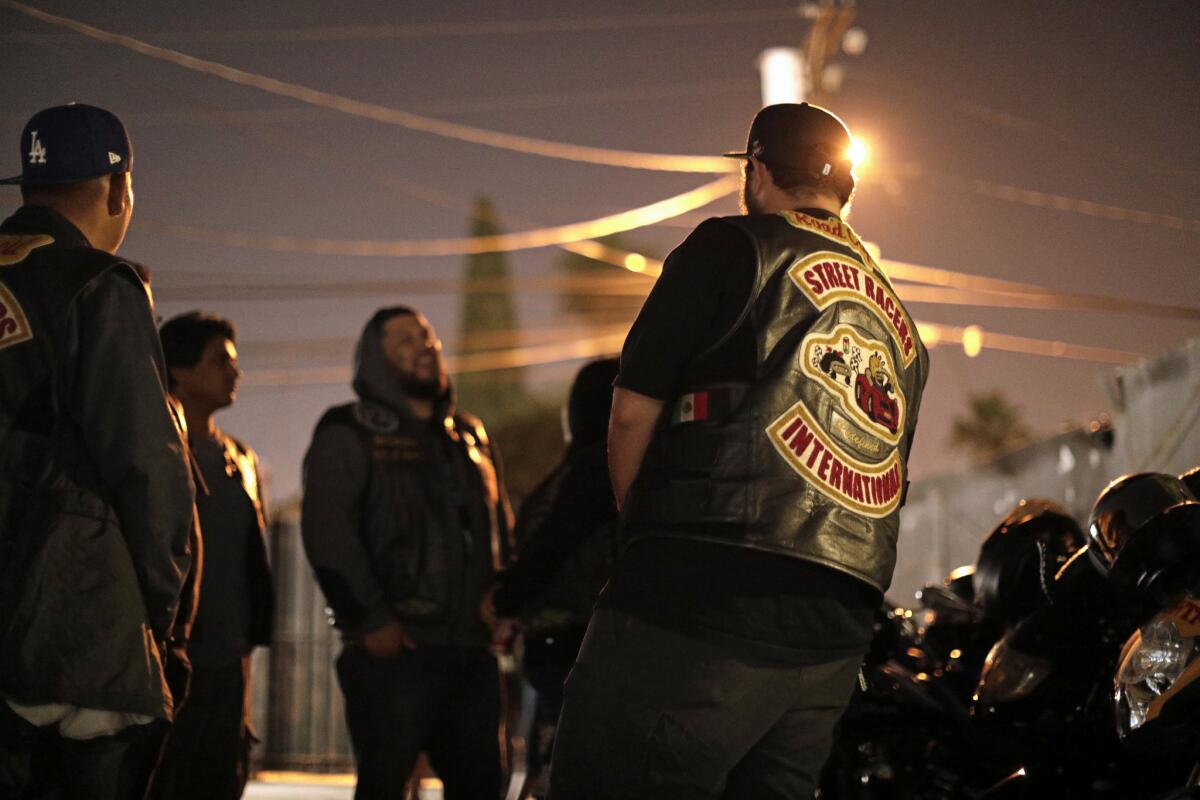
To make sense of what Willie did, I wanted to speak with his friends, family and members of the Brotherhood. I knew it wouldn’t be easy — it was evident how much Big Willie meant to people like Arroyo. He met Willie as a teenager testing his mettle at Brotherhood Raceway around 1979, and later got to know him really well — they were even housemates for a time.
A member of Guardians of the Green Beret, who requested anonymity due to the sensitive nature of the group’s work, shared some perspective on how difficult these conversations are with people close to those who have been untruthful: “You try to be as nonemotional and maybe as vanilla as possible. You tell them, ‘Don’t hate the messenger.’ You look at the claims, and all you do is provide the truth. It needs to be done.”
Breaking the news to Arroyo over the phone, the shock hollowed out his normally booming voice.
“Wow. OK,” said Arroyo.
“I think that his legacy of healing racial tensions is something that people should look back on fondly and they should try to carry that forward.”
— Kevin Walton, a former Air Force communications analyst
The silence hung in the air, but before long, Arroyo was making sense of the revelation.
“It doesn’t change the man, you know?” he said. “So he has faults. We all do. I got faults.”
Arroyo recalled the guilt Willie said he felt over “surviving the war.”
In the 2009 interview that Arroyo recorded, Willie talked about it: “My buddies are still over there dying, and losing parts of their bodies. But I come home and I’m still in one piece. And so it dawned on me. God spared me from dying in Vietnam to come home and be Big Willie.”
Now, a decade later, the guilt Big Willie wrestled with took on a new dimension.
“I think he felt guilty he didn’t fight,” Arroyo said. “Because the survivor’s guilt he had was real. He had that guilt and it was deep. You could just feel it.”
I couldn’t ask Tomiko, Willie’s wife, about his deception — she died 12 years ago at the age of 57. But I tried to discuss the military records with Willie’s family. His sister, Jean Davis-Hatcher, didn’t respond to requests for comment, including an email that laid out what the records said. But she wrote in one message: “There is nothing you could say or write that would impact our memories of Big Willie.” I did speak on the telephone with Willie’s brother. I told him what I’d learned and asked him if he knew about it. Robinson said “No.” He declined further comment and hung up.
I also rang Farrell, the former city councilman. He told me that he’d been unaware of Willie’s lie, but wanted me to understand the times.
“Willie was in the military; it was during the Vietnam era — and for me, at that particular time, that was enough,” he said. “He was a veteran. He was doing things that were positive in the community at that time.”
Farrell discussed the difficulties he himself dealt with as a black public figure during this era. So he was speaking from experience when he said that it would’ve been incredibly tough for Willie as he started out on his mission.
“It was rough,” he said. “There were moments when law enforcement was not that nice in looking at us or thinking about us.”
We will never really know why Willie lied. Presenting himself as a war hero may have opened doors for him during an era when it was especially tough being a black activist in L.A. At the same time, the stories could have given him confidence to pursue a seemingly impossible mission — building a more unified and less violent society. They may have allowed him to bury his shame over his inability to serve. Or, they may have been borne out of his real sense of duty — a desire to complete his unfinished service.
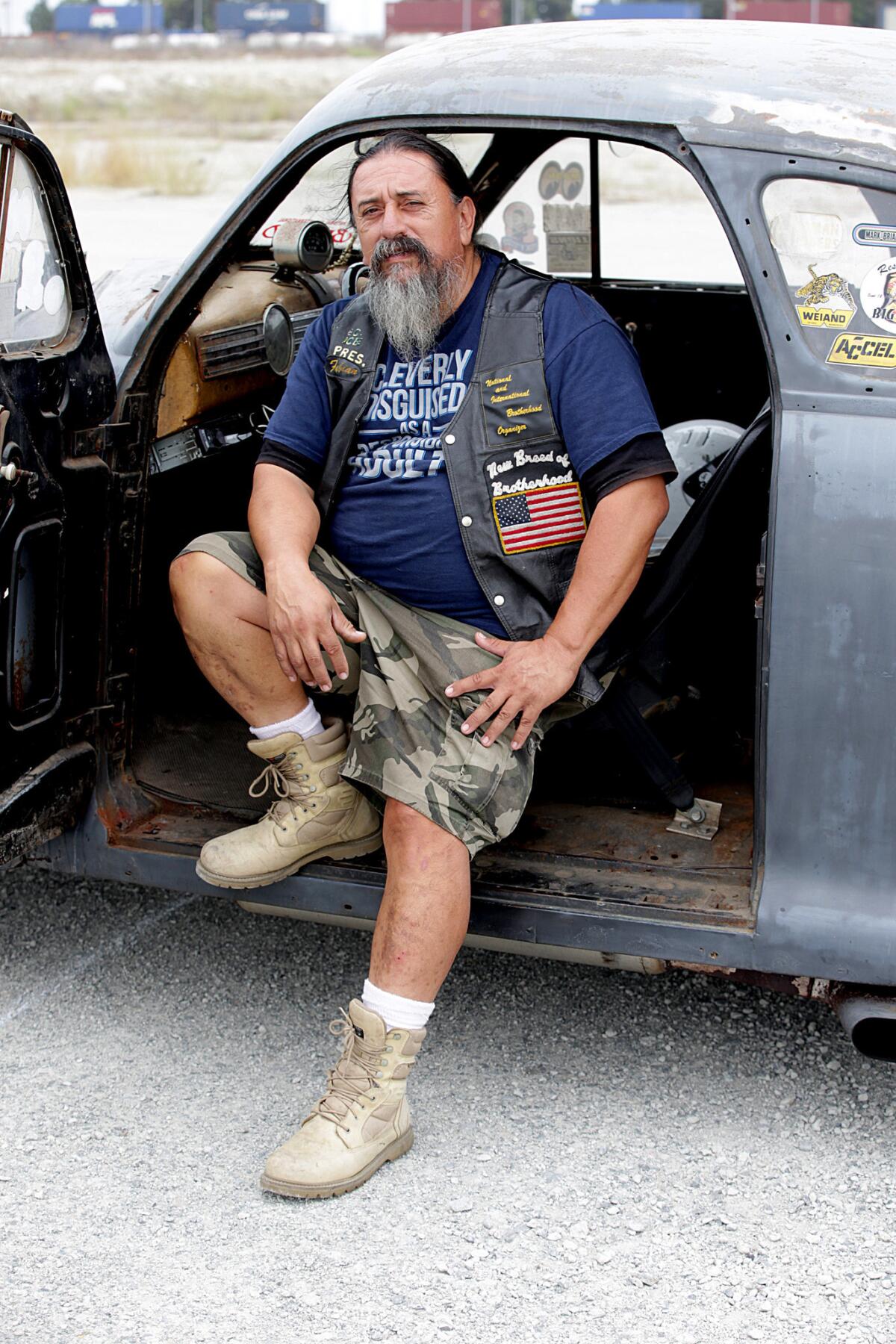
As for Arroyo, we had dinner about two weeks after I broke the news to him. We met at Musso & Frank, the old show business haunt in Hollywood. I had wondered if the conversation would be awkward, but as we drank icy gin Gibsons and tucked into medium rare rib eyes, we slipped into the familiar rhythm of a conversation about Willie, the Brotherhood and street racing.
“The reality is, people were going to find this out sooner or later, and if you try to hide something like this, you’re just going to tarnish what you’re doing in talking about him,” Arroyo said. “So why cover it up? Why try to make a lie out of it?”
After dinner, we jumped into Arroyo’s car and drove for a long time across our darkened city. The neon signs of the boulevard blinked off, a brisk breeze hustled trash across the street, and buses sighed as they pulled away from empty stops. Soon enough, we were nearing Los Feliz, where I knew Arroyo had grown up. He pointed out the restaurant that he said had been a front for the mob, the theater where he saw his first movie and the park that he and his pals used to break into after hours. Then he showed me the apartment building where he had lived. He remembered it all so vividly, but that world is gone.
“Lot of places to race at don’t exist anymore; lots of streets to race at don’t exist anymore,” Arroyo said. “Lot of cars don’t exist anymore; a lot of people don’t exist anymore.”
Big Willie was gone. And the version of Big Willie that Arroyo and so many others loved — he was gone. too. But Arroyo was OK with that. And I could see how that was possible for him. Before long, it was time to say goodbye. I didn’t know when I’d see Arroyo again. But I knew it would involve some fast cars, a late night and — one way or another — we’d wind up chasing Big Willie again.
::

Street racer Big Willie Robinson died in 2012, but the group he founded, the Brotherhood of Street Racers, carries on his absence, continuing to spread his message of unity through wheels.
Willie Andrew Robinson III died on May 19, 2012. He was 69. Heart failure brought on by an infection killed him.
On his death certificate, Willie was listed as a “race car driver.” But he was so much more than that. Brenda Stevenson, professor of African American history at UCLA, said Willie’s achievements make him an “important example for people not just in L.A., but people across the nation.”
“The LAPD was considered the enemy of the people — black people and Latino people in particular. And he made an opening for himself to be a peacemaker. And I think that that’s really his innovation,” she said.
“Lot of places to race at don’t exist anymore; lots of streets to race at don’t exist anymore. Lot of cars don’t exist anymore; a lot of people don’t exist anymore.”
— Fabian Arroyo, street racer
Willie’s message may seem Pollyanna-ish to some. But even in his day, Big Willie went against the grain. After the Watts riots, when L.A. was torn apart, he saw a different way. And he did it at a time when black men were disrespected — and oppressed. You can call Big Willie naive. You can call Big Willie a liar, but you can’t discount his charisma and resolve. And Stevenson said that could still inspire others to take up the mantle to bridge the chasm between the LAPD and whole swaths of the city that don’t trust the police.
But it wasn’t just Willie who made it happen. Let’s not forget that even if things eventually fell apart, Willie was met at several crucial junctures by cops and politicians who wanted to help him. Consider the audacity of a city that embraced the idea that Willie put forward — and gave him the tools to use street racing, of all things, to make L.A. a safer and more unified place.
“When it comes to wheels — white, black, brown and yellow; male and female; young and old; rich or poor; from gangbangers to law enforcement — with that formula you can pull your communities together,” Big Willie said.
::

Los Angeles Times staff writer Daniel Miller witnesses firsthand a street race in South Los Angeles. The experience offers up evidence of Big Willie Robinson’s enduring influence.
There was one last thing I had to do. I headed to the streets Big Willie once ruled, determined to find out if his legacy lived on in today’s street racing scene. I tried for weeks to see a race, but I kept striking out, partly due to the clandestine nature of the subculture. Eventually, though, I got a text message from Arroyo one Friday night tipping me off.
Well past midnight, I made it to a spot near 135th Street in South L.A. It was swarmed. Cars were double parked, blocking the road. Hip-hop blared from a black SUV. Someone was selling pupusas out of a van. The pent-up energy of 100 teenagers and twentysomethings thickened the air. Blacks, whites, Latinos, Asians.
It was getting louder. Bets were called out: $5 on the Camaro, 20 bucks on the Mustang.
Two cars were doing burnouts, preparing to race. They were roaring, revving their engines as they tried to time the start just right. A man stood in front of them. He was calm — smiling and joking with the other racers. He was in his element as he stared down the drivers, making eye contact with them.
This was unsafe. It was illegal.
But there were no fights and there were no crashes, even if there were close calls. This man made it that way by quietly exerting his authority. He raised his arm — he was getting ready to start the race. He turned for only a second, but I got a good look at the back of his vest. “Street Racers International,” it read.
This Brotherhood member — at least for this night — he had stepped into Big Willie’s role. In a way, it was Big Willie. He was there.
He’s wherever racers come together in peace.
The man in the vest dropped his arm. And the drivers sped off into the night.
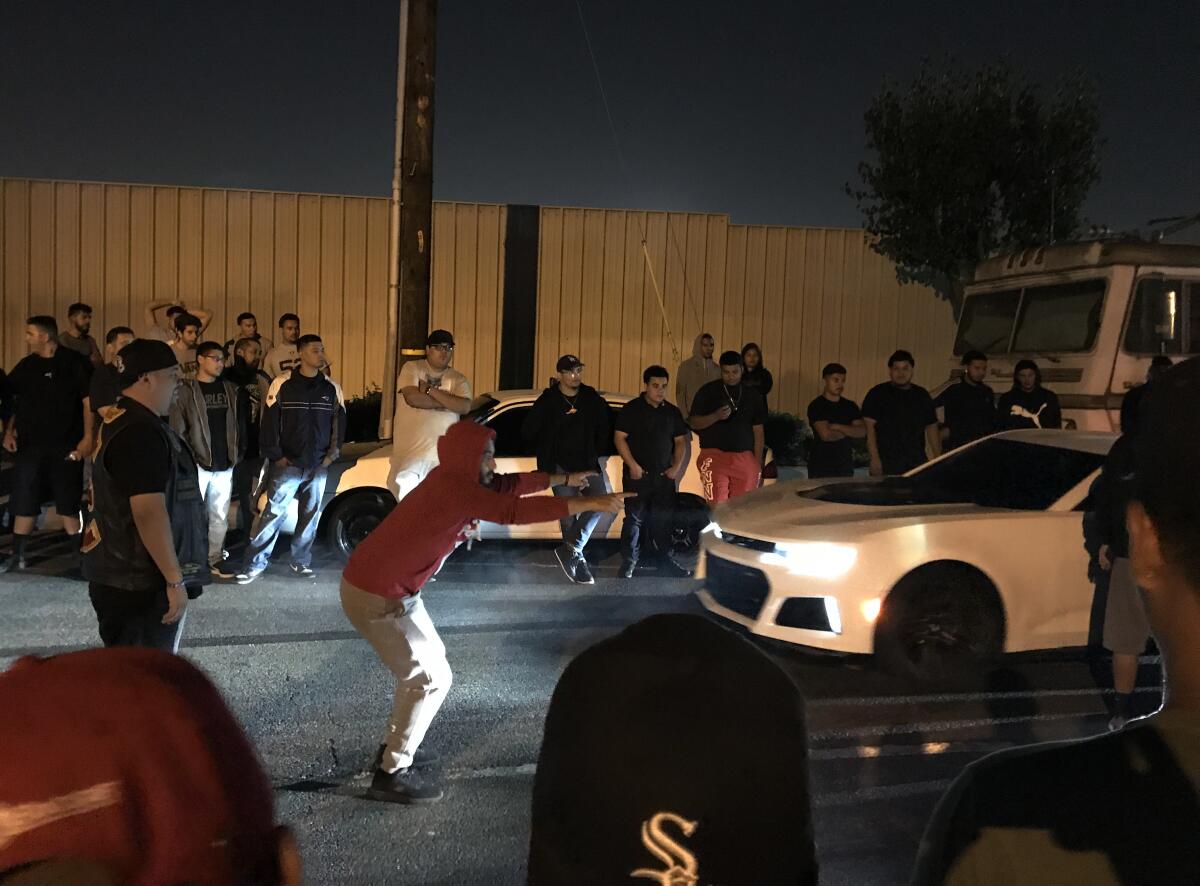
Download the “Larger Than Life” podcast and join the Facebook group to discuss the docu-series.
More to Read
Sign up for Essential California
The most important California stories and recommendations in your inbox every morning.
You may occasionally receive promotional content from the Los Angeles Times.










